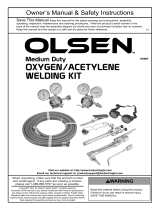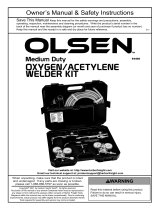
4.6. ASSEMBLING THE TORCH FOR CUTTING. (SGA6 ONLY)
WARNING! The teflon seal on the cutting attachment inlet must not be damaged or missing, otherwise gases will mix inside the
torch and result in flashbacks or backfires. Always inspect the seal, coupling nut and torch head for damage or oil. If either is found,
discontinue use and contact your supplier.
4.6.1. To change the cutting nozzle loosen and remove the nut which holds it in place and withdraw the nozzle. Slide the chosen cutting nozzle
through the nut and screw the assembly into the cutting attachment and fully tighten down.
4.6.2. Screw the cutting attachment with nozzle attached onto the torch handle as shown below. Before fully tightening the the ribbed nut, adjust
the orientation of the gas valve knobs so that they do not block the movement of the lever (B).
4.7. CONNECTING NON-RETURN VALVES AND HOSES TO THE TORCH.
4.7.1. Always fit non-return valves (not supplied) to the torch before connecting the respective hoses. Non-return valves have different direction
threads to ensure that they are fitted to the correct side of the torch. An OXYGEN non-return valve has a normal thread and will fit to the
blue coded side of the torch (See colour coding on valve knobs). An ACETYLENE non-return valve has a reverse thread and will fit to the
red coded side of the torch (See colour coding on valve knobs).
4.7.2. Connect the two hoses (not supplied) to the respective non-return valves fitted to the torch handle.
WARNING! Ensure hose fittings are sufficiently tightened to the torch, We recommend to tighten both joints at the same time using
two spanners to offer counter resistance whilst applying sufficient pressure to tighten all connections to ensure no leaks and no damage
to the torch.
WARNING! If traces of oil or grease are found, DO NOT use. Contact your gas supplier immediately.
5. WELDING
IMPORTANT. LEAK TEST ALL CONNECTIONS AND VALVES PRIOR TO EACH USE OF THE EQUIPMENT.
Note: These instructions are intended to describe the facilities and operation of the welding/cutting torch. They are not intended to
teach you how to weld or cut using oxyacetylene. If you have no experience of welding/cutting using oxyacetylene it is
essential that you seek training from a qualified person or approved training organisation.
5.1. Assemble the torch for welding as described in section 4.5 (See also fig.2)
5.2. SETTING THE GAS REGULATOR PRESSURES
5.2.1. Close the regulators by turning the adjusting screws anti-clockwise to relieve the pressure on the diaphragm before opening the cylinder
valves. Slowly open the cylinder valve on the oxygen and acetylene bottles in turn. As you do so the high pressure gauge (left hand) on
each regulator will register the pressure in the cylinder to which it is attached.
5.2.2. Slowly open each regulator in turn by turning the adjusting knob clockwise. As you do so the outlet pressure gauge (right hand) on
each regulator will register the outlet pressure of gas being fed to the torch. Adjust the pressure according to the size of nozzle in
use and the thickness of the material to be cut or welded. Refer to section 8 overleaf.
WARNING! Never set acetylene regulator at a delivery pressure above 15psi (1 bar).
5.2.3. After adjusting the regulators check for leaks at all connections. If a leak is found, tighten fitting more securely. If leak persists, discontinue use
and call your supplier.
5.2.4. Briefly open and close the oxygen valve on the torch handle to check that the gas is flowing.
5.2.5. Similarly open and close the acetylene valve on the torch handle to check that the gas is flowing.
WARNING! Always use welding gloves and suitable eye protection when welding or cutting. Contact your local Sealey stockist for a
full range of protective equipment.
5.3. LIGHTING THE TORCH Ensure that the gas hoses will not be in the way of the torch when ignited. Ensure that the torch is facing
away from you before lighting.
5.3.1. Holding the torch in one hand and the striker in the other open the acetylene valve a 1/4 turn (the valve knob is colour coded red).
Operate the striker close to the tip to light the acetylene.
5.3.2. The first flame that appears will be an orange/yellow colour giving off a small amount of black smoke from its tip. If too much acetylene is
flowing the flame will be standing away from the tip of the torch making a roaring noise. In extreme cases this type of flame can blow itself
out. To correct such a flame reduce the amount of acetylene until the flame is 8 to 10 inches long with less black smoke.
5.3.3. Once the acetylene flame is set correctly begin to introduce oxygen by slowly opening the oxygen control valve on the torch (The
valve knob is colour coded blue). The flame will change to a whitish colour and the black smoke will disappear. This flame is not hot
enough for welding.
5.3.4. Add more oxygen to the flame by further opening the control knob until a brilliant neutral flame is achieved.
5.4. SHUTTING DOWN AND LEAVING SAFE
5.4.1. Turn off the acetylene valve on the torch first and then turn off the oxygen valve a few moments later. Note: Turning the gases off in
the wrong order can cause damage to the torch.
5.4.2. Close both cylinder valves.
5.4.3. Drain gas from oxygen regulator by opening the oxygen valve on the torch handle. Similarly drain gas from the acetylene regulator.
5.4.4. Release the adjusting knobs on the regulators. This is done by turning them anti-clockwise.
Original Language Version
© Jack Sealey Limited
Fig.3
SGA2.V2, SGA6.V2 Issue:2 (1,4) 10/08/21









